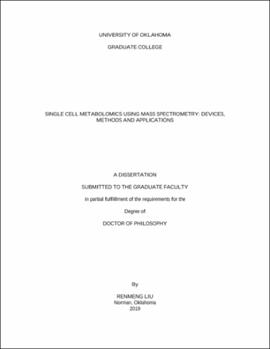| dc.description.abstract | Cells are basic functional components of eukaryotic organisms containing rich biological and physiological information. To investigate the nature of cells, a variety of fundamental and mechanistic studies of the cell functions, cellular metabolisms, metabolomic pathways, cell-cell interactions, and the interaction between cells and the surrounding microenvironment, to name a few, were conducted in recent years. Besides considerable achievements, cell-to-cell heterogeneity was recognized as the intrinsic property of cells, that is, individual cells possess unique biological traits different from other cells, even compared with their neighbors of the same genotype. Unfortunately, such cell-to-cell heterogeneity is masked by conventional analysis at the cell population level, which generally results in an averaged signal of all cells analyzed. Therefore, analytical methods that well appreciate the cell heterogeneity are desired to investigate cells at a higher resolution, that is, at the single cell level.
However, several major challenges exist in conducting single cell-level studies. First, the volume of a single cell is small (i.e., ~10 µm in diameter of a mammalian cell). Due to such dimension, the analyte within a single cell is extremely limited. Second, it is difficult to handle single cell samples due to the fragile nature of single cells. Third, some cellular species are prone to rapid turnover, and therefore, a departure from near-native biological microenvironment. Therefore, in this work, an integrated and multifunctional device, the T-probe, was designed and fabricated to conduct online and in situ analysis of live single cells at ambient condition in chapter 2. After the data acquisition, a comprehensive and generalized data analysis workflow was proposed to conduct single cell metabolomics and reveal the underlying biological principals beneath the complex raw data matrix in chapter 3. The initial data acquisition and the metabolomic analysis were further combined with more advanced data analysis methods such machine learning (ML) algorithms using artificial intelligence to handle big data to learn the underlying patterns of cellular metabolisms, and ultimately facilitating decision making. In chapter 4 and 5, different ML models were constructed based on the acquired datasets of single cells, and evaluated in terms of the predictive accuracy of an unknown single cell possessing drug resistance. Rapid and reliable predictions of cells possessing primary or drug-induced resistance were demonstrated using established ML models on the testing datasets, and the robustness of the model was validated through accurate predictions of cells on a different batch. Such results suggested promising potential of the ML models towards future point-of-care (POC) prognostic assays. | en_US |
